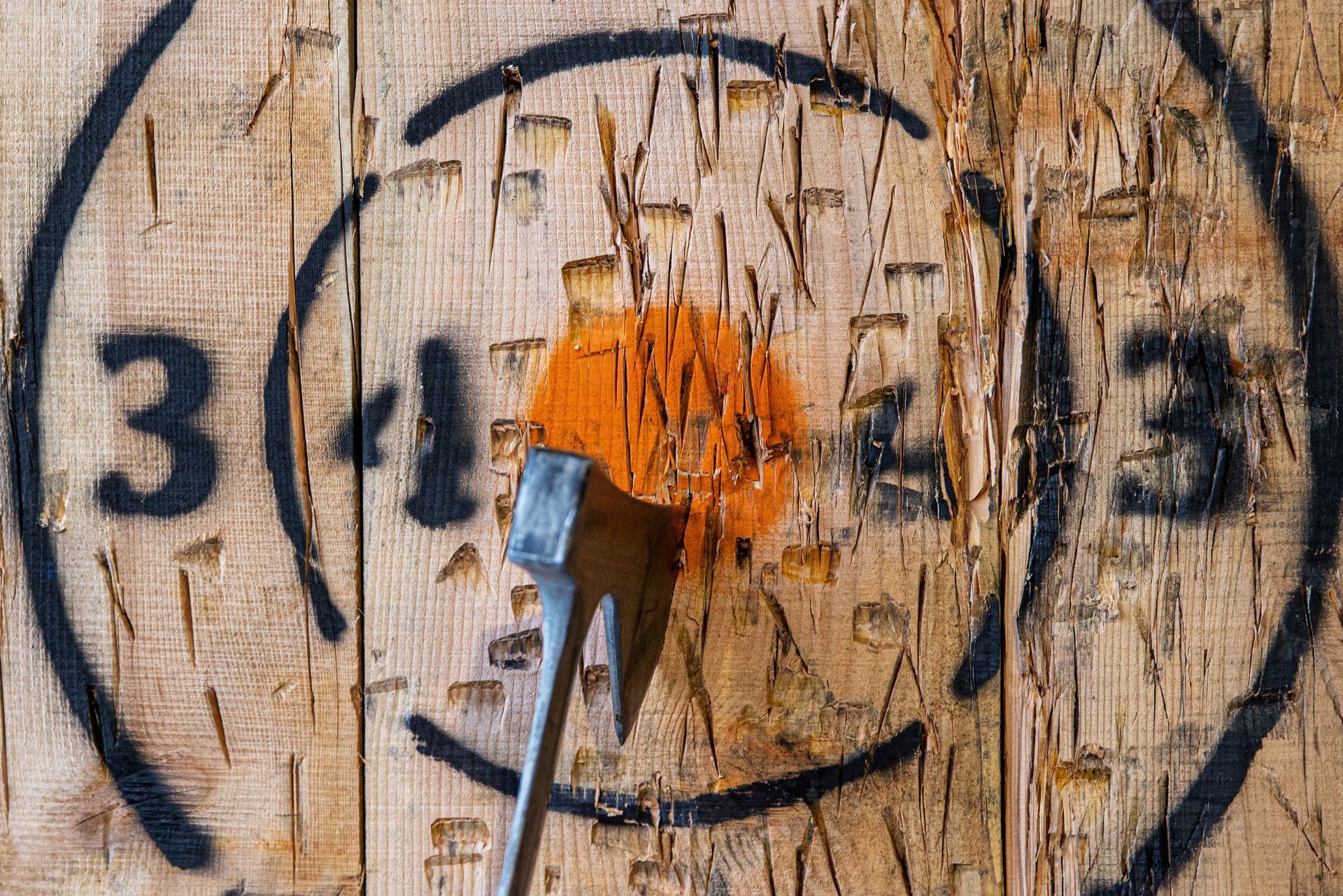Top 3 Recommended Policies

Axe throwing venues have grown from niche entertainment spots into mainstream social destinations. In Florida, this growth comes with specific operational, legal, and environmental factors that make insurance not just recommended, but essential. This guide explains the types of coverage needed, cost factors, regulatory considerations, risk management practices, and practical steps to secure the right policy for an axe throwing business operating in the Sunshine State.
Why Axe Throwing Businesses Need Insurance in Florida
Axe throwing is inherently high-risk because it involves sharp objects, close human interaction, and a social environment that sometimes includes alcohol. Even with stringent safety protocols, accidents happen—slips, misthrows, property damage, and customer injuries are real possibilities.
Florida's large, diverse population and heavy tourism traffic increase exposure to incidents and claims. Additionally, state laws, local ordinances, and venue-specific risks like severe weather or building vulnerabilities make tailored insurance coverage critical for financial protection and regulatory compliance.
Liability Exposure and Public Safety
Customers may suffer cuts, lacerations, blunt trauma, or even more serious injuries that lead to medical bills and lawsuits. General liability and premises liability insurance protect against claims arising from bodily injury and property damage to guests and third parties.
Employee-Related Risks
Staff are at risk during instruction, axe maintenance, and crowd control. Workers’ compensation is often required for paid employees and covers medical care, lost wages, and certain legal costs if an employee is injured on the job.
Business Interruption and Property Risk
Florida’s hurricane season and flood exposure mean physical damage to the facility can disrupt operations. Property and business interruption coverage help recover repair costs and lost income during closures, which is particularly important for businesses reliant on weekend and evening traffic.

Primary Types of Insurance for Axe Throwing Venues
Multiple insurance products should be considered to build a comprehensive protection plan. Policies can be bundled or purchased separately, depending on the insurer and the business’s size and risk profile.
General Liability Insurance
General liability covers claims of bodily injury and property damage arising out of normal operations. It responds to customer injuries, tripping accidents, and damage to third-party property. Limits are usually expressed as per occurrence and aggregate (e.g., $1M per occurrence / $2M aggregate).
Commercial Property Insurance
Property insurance covers physical assets such as the building contents, axes, target boards, and furnishings. Policies can include replacement cost for items and may be expanded to cover forced closure due to covered perils.
Workers’ Compensation
Workers’ compensation covers employee medical costs and wage replacement for workplace injuries. Florida law requires businesses with employees to carry workers’ comp, with certain exceptions for very small operations or sole proprietors—local rules and exemptions should be reviewed carefully.
Liquor Liability Insurance
Many axe throwing venues serve alcohol to increase revenue and enhance the social experience. Serving alcohol raises the risk of intoxication-related incidents and third-party injury claims. Liquor liability coverage protects the business if a patron causes harm after being served at the venue.
Professional Liability / Instructor Liability
Instructional errors or failure to supervise properly can lead to claims that may not be covered by general liability. Professional liability policies for trainers and staff can fill gaps related to instructional negligence or inadequate training protocols.
Umbrella and Excess Liability Insurance
Umbrella policies provide additional liability limits above the standard general liability and employers’ liability coverages. For venues exposed to large jury verdicts or high-risk claims, an umbrella policy offers an extra layer of financial protection.
Business Interruption and Contingent Business Interruption
Business interruption insurance replaces lost income and covers ongoing expenses if the venue must close because of a covered peril. Contingent business interruption applies when a supplier or nearby business issue indirectly affects operations.
Cyber Liability Insurance
Sales systems, online booking platforms, and customer databases create exposure to data breaches. Cyber liability covers expenses related to data breach response, notification, credit monitoring, and certain legal costs.
Coverage Specifics and Typical Policy Limits
Understanding policy limits, exclusions, and endorsements is essential when buying coverage. Policies should match the scale of operation, guest capacity, alcohol service, and regional risks.
Typical Liability Limits and Recommended Minimums
Common minimums for a small to mid-size venue are $1 million per occurrence and $2 million aggregate for general liability. Larger venues or locations serving alcohol often need $2 million to $5 million in combined limits. Umbrella policies often start at $1 million increments above underlying coverage.
Property Coverage Details
Property policies may exclude flood and hurricane-dedicated damage unless specifically added. Replacement cost coverage is preferable, but actual cash value policies can be less expensive while offering lower payouts for older assets.
Exclusions and Important Endorsements
Liability policies sometimes include exclusions for high-risk activities or require specific safety protocols to be in place. Endorsements can add coverage for assaults and battery, liquor liability, or coverage for rented equipment. Review exclusions carefully to avoid coverage surprises after a claim.
Florida-Specific Risks and How They Affect Insurance
Operating in Florida introduces unique risk factors—weather, tourism, population density, and regulatory nuances—that influence coverage choices and premiums.
Weather and Natural Disasters
Hurricanes, tropical storms, and flooding are recurring threats. Standard property policies may not include flood coverage, and hurricane-related windstorm losses might require separate wind/hurricane deductibles or endorsements. Business interruption coverage should consider extended closure scenarios due to storm damage.
Tourism and Transient Customer Base
High visitor turnover increases exposure to unfamiliar patrons who may misjudge throwing safety or consume alcohol unpredictably. Policies should account for higher foot traffic and a mix of local and out-of-state customers.
Local Regulations and Municipal Differences
Municipalities may have different licensing, zoning, or safety inspection requirements. Some cities and counties have stricter building codes or noise ordinances that influence operational practices and risk. Insurers sometimes require proof of local compliance as part of underwriting.
How Much Does Axe Throwing Insurance Cost in Florida?
Insurance premiums vary widely based on location, size, revenue, number of lanes, guest capacity, alcohol service, safety programs, claims history, and selected limits and deductibles. A few guiding principles can help estimate costs.
Factors That Drive Premiums
Key cost drivers include coverage limits, number of employees, annual revenue, whether alcohol is served, and the claims history of the business. Additional drivers include building age, proximity to flood zones, and loss control measures in place.
Estimated Price Ranges
For small venues without alcohol and basic safety measures, general liability and property coverage combined might start in the low thousands per year. Venues serving alcohol and with larger capacities commonly see premiums in the mid to high thousands, with higher limits, umbrella policies, and hurricane/flood endorsements pushing totals into five figures annually. Obtaining multiple quotes tailored to the specific business model is essential for accuracy.
Ways to Lower Premiums
Implementing robust safety protocols, hiring experienced instructors, installing surveillance and controlled entry, offering staff training (e.g., certified axe instructor programs), and maintaining a clean claims history can reduce premiums. Bundling policies with a single insurer and increasing deductibles are also common strategies to lower annual costs.

Choosing the Right Insurance Provider or Broker
Selecting an insurer or broker that understands the niche risks of axe throwing is as important as the policies themselves. Experienced underwriters and specialty brokers can craft coverages that general business policies might omit.
Work with Specialty Insurers or Experienced Brokers
Seek brokers with experience in entertainment, sports, and hospitality exposures. Specialty insurers are more likely to offer tailored endorsements, reasonable underwriting, and a better understanding of safety initiatives specific to axe throwing.
Questions to Ask Prospective Insurers
Important questions include: Do policies cover alcohol-related incidents? Are there exclusions for certain throwing activities? How are natural disaster losses handled? Is assault and battery coverage included or available as an endorsement? What are the claim handling procedures and typical payout timelines?
Policy Comparison and Renewal Considerations
Compare policy limits, exclusions, deductibles, and premium trends across multiple insurers. Consider multi-year rates and how premiums have changed at renewal, especially after any claims. Building a long-term relationship with a trustworthy broker helps in negotiating better terms and managing renewals.
Risk Management: Reducing Incidents Through Policies and Procedures
Insurance is only part of a risk strategy. Effective risk management reduces incidents, lowers premiums, and improves the guest experience. Attention to training, facility design, and operational policies pays dividends.
Staff Training and Certification
Comprehensive training programs for instructors should cover safe throwing techniques, emergency response, conflict de-escalation, and alcohol service responsibility when applicable. Documentation of training and certification programs demonstrates due diligence to insurers and regulators.
Facility Design and Safety Equipment
Proper lane design, secure backstops, clear signage, non-slip flooring, and well-maintained axes and targets reduce accidents. Installing barriers, one-way lanes, and spectator zones creates separation between throwers and onlookers.
Written Policies and Incident Protocols
Standardized policies for age limits, intoxication handling, lane assignment, supervision ratios, and equipment inspection help enforce consistent safety standards. Incident reporting protocols and regular drills ensure quick, documented responses to emergencies or accidents.
How to Get Insured: Practical Steps
Securing appropriate insurance involves preparation, documentation, and comparing offers. A structured approach helps ensure coverage gaps are avoided.
Prepare a Risk Profile
Gather details like annual revenue, number of employees, lane count, maximum guest capacity, alcohol service details, safety protocols, training documentation, and claims history. This information is essential for accurate quotes and underwriting.
Request Multiple Quotes and Compare Carefully
Obtain quotes from at least three insurers or brokers, comparing not only price but coverage limits, exclusions, endorsements, and claim handling quality. Pay close attention to exclusions related to assaults, alcohol, and natural disasters.
Negotiate Endorsements and Add-Ons
Discuss adding endorsements like assault and battery, liquor liability, business interruption with extended limits, or flood coverage where needed. Make sure cyber liability and equipment breakdown are considered if the venue relies on point-of-sale systems and digital bookings.
Claims Handling and What to Expect
Understanding how to handle claims efficiently helps minimize disruption and preserve relationships with both customers and insurers.
Immediate Steps After an Incident
Ensure medical needs are addressed first, secure the area, collect witness statements, and document the scene with photos and video when possible. Preserve evidence such as damaged axes, targets, and surveillance footage for insurer review.
Filing the Claim and Cooperation
Report claims promptly to the insurer and provide complete documentation. Cooperate with the insurer’s investigation and follow legal advice if a lawsuit seems likely. Timely and transparent communication often speeds resolution and reduces the chance of claim denial for non-cooperation.
Mitigating Post-Claim Risks
Review the incident to identify procedural or training gaps that contributed to the claim. Implement corrective actions and document changes to present to the insurer at renewal—demonstrating improvements can help prevent premium increases.
Legal and Regulatory Considerations in Florida
Beyond insurance, compliance with state and local regulations reduces legal risk and improves community standing. Understanding permits, liability waivers, and local code requirements is essential.
Waivers, Releases, and Their Limitations
Liability waivers can reduce the likelihood of certain lawsuits, but they are not absolute protection. Florida courts may enforce waivers under many circumstances, but waivers cannot typically shield a business from gross negligence or willful misconduct claims. Waivers should be written clearly and reviewed by legal counsel.
Licenses and Local Permits
Permits may be required for operating an entertainment venue, serving alcohol, or holding events. Building codes, occupancy limits, and signage permits vary by municipality. Compliance with local health and safety inspections is often required by insurers as well.
Age Restrictions and Alcohol Laws
Florida law regulates alcohol service and requires staff to follow responsible service practices. Establish and enforce clear age restrictions for throwing sessions, and implement policies to refuse service to visibly intoxicated patrons.
Frequently Asked Questions (FAQs)
Common questions about axe throwing insurance often revolve around coverage needs, costs, and legal protections. Clear answers help operators prepare for underwriting and operations.
Is Insurance Required to Open an Axe Throwing Venue in Florida?
Insurance is not universally mandated at the state level for every aspect of operation, but workers’ compensation is generally required for employees, and many municipalities require proof of insurance for business licensing. Additionally, landlords and lenders often require specific coverage as a lease or loan condition.
Will a Standard Business Policy Cover Axe Throwing?
A standard business owners policy (BOP) may not fully cover the unique risks of axe throwing, especially if alcohol is served or the venue hosts large crowds. Specialty endorsements or separate policies for liquor liability, assault and battery, and higher liability limits are often needed.
How Much Liability Coverage Is Enough?
Coverage needs vary. Small venues may be comfortable with $1M/$2M limits, but those serving alcohol or operating in high-traffic tourist areas should consider $2M to $5M limits or higher, often supplemented with umbrella coverage.
Does Insurance Cover Intoxicated Patrons Who Get Hurt?
General liability can cover injuries to intoxicated patrons in many circumstances, but if a venue is found negligent in serving alcohol to a visibly intoxicated person, liquor liability could apply for third-party injuries resulting from their actions. Service policies and staff training are critical to defense.
Final Considerations and Best Practices
Running a successful and sustainable axe throwing business in Florida requires combining strong insurance coverage with proactive risk management and regulatory compliance. Insurance safeguards the financial future, but prevention is the best defense.
Regularly Review and Update Coverage
As the business grows, revisit coverage annually or after significant changes: adding lanes, increasing capacity, adding alcohol service, or expanding to new locations. Policies should evolve with operations to avoid coverage gaps.
Maintain Documentation and Relationships
Keep organized records of training, safety inspections, maintenance, incident reports, and communications with insurers. Building a strong relationship with a broker and insurer experienced in entertainment and sports venues ensures better outcomes when underwriting or claims arise.
Invest in Safety and Community Reputation
Public perception affects revenue and risk. Investing in experienced staff, visible safety protocols, good lighting, clean facilities, and strong customer service reduces incidents and builds a reputation that attracts repeat business and positive reviews.
Securing the right insurance for a Florida axe throwing venue is a multi-step process that balances cost, coverage, and operational realities. With an informed approach—choosing appropriate policies, implementing solid safety protocols, and maintaining regulatory compliance—venues can protect their business, employees, and customers while delivering an enjoyable and memorable experience.
Contact Us


